
Installation and Reference for the BayStack 820 ISDN Router
7-2
206901-A
North American Switch Type Defaults
You can configure up to two phone numbers for North American switch types
(NI-1, ATT5ESS (Multipoint), ATT5ESS (Point-to-Point), and NT DMS-100). By
default, Directory Number 1 (DN1) is associated with voice port A and Directory
Number 2 (DN2) is associated with voice port B. A call received on DN1 rings the
device attached to voice port A and a call received on DN2 rings the device
attached to voice port B.
If an outbound call is placed from voice port A, DN1 is used, if available. If the
number is in use, DN2 is used. Similarly, a call placed from voice port B uses
DN2. If that number is in use, DN1 is used. If both B channels are busy, the caller
receives a busy signal after dialing.
All Other Switch Type Defaults
You can configure up to three Directory Numbers for all other switch types (Japan
(INS Net), Europe (ETSI), Taiwan). By default, DN1 is associated with both voice
ports. An outbound call placed from either of these voice ports attempts to use
DN1. Inbound calls ring both ports by default. The first phone to answer is
connected.
Configuring the Router for Direct Calling
The two phone numbers, called “Directory Numbers,” are normally associated
with the two ISDN channels over a single ISDN line. When you configure the
voice ports, you assign a Directory Number to each port. You can also assign an
extension number to each port that can be used to dial between extensions and to
direct calls received from outside.
Note:
If your ISDN service provider offers a third ISDN Directory Number,
you can configure it with a command line interface (CLI) command. For
details, refer to
Chapter 10, “Using the Command Line Interface
.”
Summary of Contents for BayStack 820
Page 8: ...viii 206901 A ...
Page 22: ...xxii 206901 A ...
Page 26: ...xxvi 206901 A ...
Page 44: ......
Page 62: ......
Page 122: ......
Page 132: ......
Page 258: ......
















































